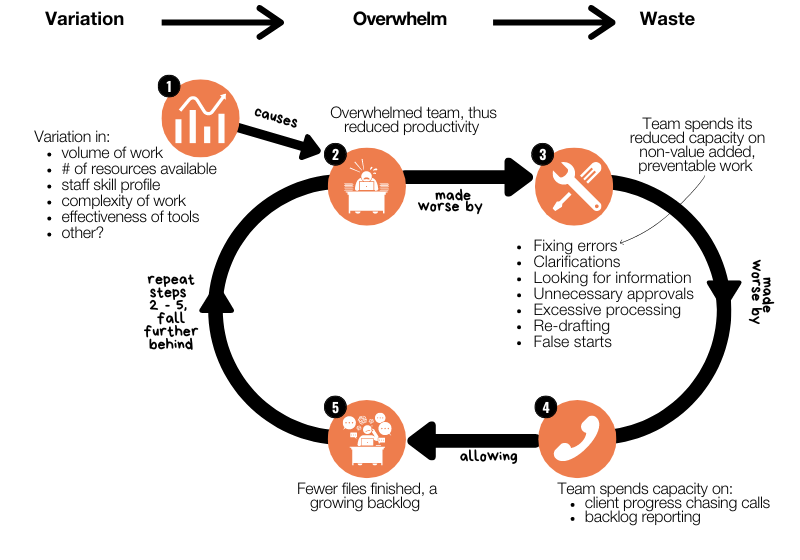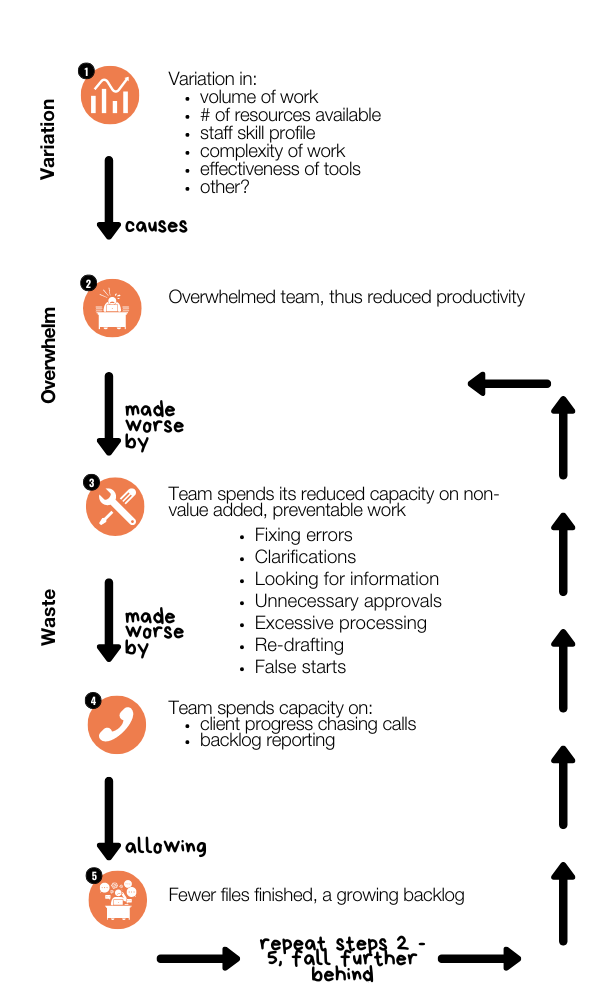Ever feel like that ever-growing backlog of unstarted or unfinished files has a life of its own? It can be hard to make progress on it, especially while clients keep calling, new requests come in and staff are busy creating backlog reports. You bring in temporary help to try to fix the problem but it doesn’t work, and you’re left with low staff morale and an even larger backlog. If only you could blow up that backlog.
You can. Lean thinking can help you identify and eliminate wastes in a process so that you can finally break the cycle of backlogs and prevent them for re-occurring.
Taking a Lean approach highlights how backlogs can form and grow as a result of three main categories of waste.
- Variation in the:
- Volume of work
- Number of resources available
- Staff skill profile
- Complexity of the work
- Effectiveness of the tools
- Overwhelm:
- Staff who are less productive because they are overwhelmed by the work
- Waste:
- Process inefficiencies: the 8 Lean Wastes including:
- Defects
- Overproduction
- Waiting
- Not fully utilizing people
- Transport
- Inventory
- Motion
- Excessive Processing
- Process inefficiencies: the 8 Lean Wastes including:
These concepts are explored in detail in an article we wrote for Canadian Government Executive Magazine referencing real-life impact of these wastes and tips on how to deal with them.
The following graphic is a useful summary to see how Lean thinking can help you identify how and where you could begin to eliminate backlogs at your organization.
In this content area, we cover:
- Analysis of your backlog – is it a “current” backlog (your process is unable to keep up with current demand) or a “historic” backlog (your process is capable of keeping up with current demand, if the existing backlog did not exist). Different backlog types require different strategies to succeed.
- How to create and execute your backlog strategy, including:
- How to identify the variation that started or perpetuates the backlog cycle; identify root causes.
- Strategies to reduce unreasonableness, and the resulting overwhelm on staff and leaders to create better focus, productivity and morale.
- Strategies to identify and eliminate failure demand
- Strategies to identify and eliminate other wastes that prevent you from keeping up with demand
- Strategies to communicate with your stakeholders to influence their behaviour, using the principles of “Nudge” / behavioural economics to understand their interests and create behaviours that support your backlog reduction strategy.
- How to create buy-in to your strategy inside and outside of the organization, at multiple levels.
- How to execute your backlog strategy using the principles of Lean and Agile/Scrum
References
Seddon, J. (2019, October 28). Failure Demand: John Seddon Vanguard Consulting. Vanguard. https://vanguard-method.net/failure-demand/
Nudge Theory. ( 2012 April 12) In Wikipedia. https://en.wikipedia.org/wiki/Nudge_theory



